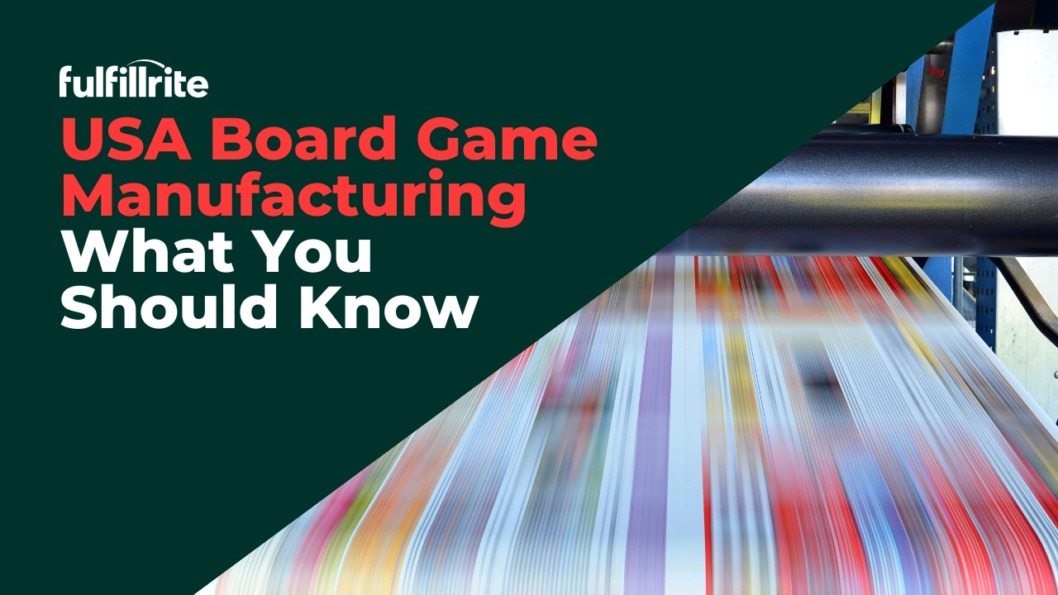If you’re thinking about making your board game in the United States, you’re not alone. Between rising overseas shipping costs, supply chain delays, and the threat of tariffs, a lot of board game publishers are considering manufacturing games in the US.
That’s why I sat in on a panel at GAMA 2025 called Domestic Manufacturing in the United States. The panel featured three experienced voices in the industry: Tavis Parker from The Game Crafter, Nick Haas from Delano Games, and Hung Le from Cartamundi. Each brought a unique perspective, from print-on-demand and small-run jobs to high-volume mass production.
In this post, we’re sharing 8 key pieces of wisdom from their discussion—covering everything from turnaround times and tooling to sourcing materials and setting realistic expectations.
Whether you’re a first-time creator or a seasoned publisher, this post is here to help you better understand what domestic manufacturing can (and can’t) do for your next project.
1. There are many reasons to consider manufacturing in the USA.
Manufacturing your game in the U.S. can help you avoid some of the biggest risks in the industry today—delays at sea, customs holdups, port strikes, and rising political tensions. “You don’t want to put all your eggs in one basket,” said Hung Le of Cartamundi, stressing the importance of diversifying your manufacturing sources.
Domestic production also gives you a major speed advantage. Nick Haas from Delano mentioned fulfilling a 25,000–50,000 unit order in just three weeks—something that would be impossible with a trans-Pacific supply chain. Shipping from a U.S. facility takes days instead of months, and eliminates overseas freight altogether.
Communication is also much easier. You’re in the same time zone, speaking the same language, and can often visit the factory in person. Finally, domestic production can reduce your environmental impact, especially as European markets push for stricter sourcing rules. FSC-certified paper is becoming more important—and harder to get.
2. U.S. manufacturing can do a lot — but there are some places where overseas manufacturers still shine.
The biggest challenge with U.S. manufacturing is cost. “The average Chinese worker makes in a day what an American makes in an hour,” said Nick Haas, pointing out the 7x wage difference.
Domestic plants use automation and tech to close part of that gap—but some labor-intensive tasks are still more feasible overseas. That includes things like stuffing tokens into cloth bags or assembling small parts by hand.
Certain components—especially plastics, bags, and novelty items—are hard to source domestically. Even Cartamundi, with full molding capabilities, still imports some specialty pieces.
There are also technological gaps. While U.S. printers are catching up, China still leads in gang-running multiple SKUs, swapping art mid-run, and producing at massive scale with extreme efficiency. “They’ve built entire systems around it,” said one panelist.
U.S. factories can often match the quality—but not the tooling or labor structure that makes it cost-effective at volume.
3. Different manufacturers have different specialties.
When considering manufacturing in the US, it’s important to recognize that different manufacturers perform better at different tasks.
The Game Crafter focuses on low-volume, custom-friendly manufacturing. Tavis Parker described their service as “the stepping stone” for game designers.
With 28,800 components in stock, no MOQs, and full online ordering, they’re ideal for prototypes and early-stage launches. They also offer a crowdfunding tool, custom 3D printing, and a concierge team for complex projects.
Delano Games shines in the 2,000–20,000 unit range. Nick Haas emphasized their speed and flexibility, including the ability to fulfill directly from the production floor to Kickstarter backers. Delano provides offset printing with attentive support.
Cartamundi handles the biggest jobs. Hung Le spoke about their 1.2M sq ft Massachusetts facility, built for large-scale runs of cards, packaging, and molded plastics. They print high-profile games like Pokémon and Monopoly, with strong security protocols and efficient logistics. They’re ideal for publishers who need scale and speed.
4. Paper is a huge part of board games, and sourcing it is about to become more complicated.
Starting in late 2025, new EU regulations will require proof that your paper products don’t contribute to deforestation. FSC certification will likely become the standard—but only about 15% of U.S. pulp currently qualifies.
That’s a concern for any publisher looking to export to Europe. Nick Haas from Delano Games raised the issue during the panel, noting that the change will especially affect smaller domestic forests for pulp, many of which are family-run and not set up to provide this documentation.
The scramble for certified stock could drive up prices and limit availability. Some manufacturers are already preparing. Tavis Parker mentioned buying larger paper reserves months in advance, not just to hedge against costs but to ensure they can meet demand without delays.
While not an immediate crisis, it’s a trend publishers need to watch closely if they plan to sell in Europe.
5. Domestic plastics and component limitations
If your game includes plastic pieces or metal tokens, domestic manufacturing may hit some roadblocks. As several panelists pointed out, the U.S. simply doesn’t have the same depth of component options as overseas manufacturers.
Plastics are a particular challenge—U.S. factories tend to focus on large-scale industries like automotive and pharmaceuticals. That leaves games with fewer affordable suppliers.
Cartamundi has 31 injection molding machines and can produce many standard pieces in-house, but even they acknowledge limits. For anything out of the ordinary, some turn to 3D printing farms, like those at The Game Crafter, to fill gaps.
Still, if your game requires labor-heavy assembly—say, sorting tokens into bags—expect higher costs or slower lead times. “That’s where China still wins,” said one panelist, referring to the ability to assign 50 people to an assembly line if needed.
Domestic capacity is improving, but specialty parts and fine assembly remain difficult to scale affordably in the U.S.
6. Game complexity impacts manufacturing decisions.
Not every game is a fit for domestic production. The more complex your components and assembly needs, the more likely you’ll need to look overseas. “If your game has punchboards with tokens that go into bags, that’s tough to do here,” said one speaker.
It’s not about quality—U.S. plants like Cartamundi and Delano can hit high standards—it’s about cost and logistics. When a game requires many steps, hands-on labor, or unique materials, Asian factories are still more equipped to handle the process efficiently.
Even high-capacity U.S. manufacturers sometimes recommend offshoring when a project exceeds what can be done cost-effectively in-house. On the flip side, if you’re working with a streamlined format—standard cards, simple boxes, or a single mold—it’s much easier to keep production local.
Complexity itself isn’t the issue. It’s whether that complexity requires resources and workflows that domestic facilities can handle at your scale and price point.
7. U.S. manufacturers can provide consulting services for complicated issues like file prep.
Interest in U.S. manufacturing has surged since COVID exposed the fragility of global shipping. Delays, lost containers, and skyrocketing freight costs pushed many publishers to explore domestic options. But that shift brings its own learning curve—especially for first-time designers.
“Design your files in CMYK, not RGB,” said Nick Haas from Delano. “300 DPI, full bleed, proper dielines—these are basic things that avoid disappointment later.”
The panelists agreed: better file prep saves time, money, and sanity. The Game Crafter’s platform helps with this through automated file checks and online pricing tools, but even then, early-stage creators often need help.
That’s why some companies offer concierge services or hands-on consulting. The goal is to guide publishers through the print process before costly mistakes happen. If you want your game to look great in print—and stay on budget—it pays to get familiar with production standards, or at least work with someone who is.
8. Think twice about pricing.
Domestic production is rarely cheaper—but many publishers are underpricing their games anyway. “If you’re selling a game for $20 and it costs you $9 [per unit] to print 2,000 copies, how do you make money?” asked one speaker.
Inflation, labor costs, and materials are all up—and it’s not sustainable to ignore that. Still, nobody wants to be the first to raise prices and risk losing sales. One solution: be transparent. “Spell it out,” said Tavis Parker. “Tell your customers the five reasons your game costs more now—paper, packaging, shipping, wages, benefits.”
If you’re clear and respectful, many people will understand. To paraphrase one panelist, consumers routinely spend $60 on takeout. A well-made board game should be worth that and more. If you believe in the product and you’ve run the numbers, don’t be afraid to charge what you need to. It’s not about gouging—it’s about survival, sustainability, and respecting your own work.
Final Thoughts
Domestic manufacturing isn’t a silver bullet—but it’s no longer a fringe option, either. It’s a viable path for many creators, especially those who value speed, flexibility, and long-term resilience.
The key is knowing what each manufacturer does best, understanding your game’s specific needs, and building relationships that go beyond simple transactions. The best results come from collaboration, not just cost comparison.
Every panelist emphasized one thing: this is still a people business. Whether you’re prototyping a passion project or shipping 50,000 units, your manufacturing choices shape more than your margins—they shape how quickly and reliably you can deliver what you’ve promised.
If you’re serious about publishing, it’s worth investing the time to learn the possibility of producing games in the U.S. It may not be a good fit for your business, but it’s worth considering all the options available to you before committing to manufacturing in China.

